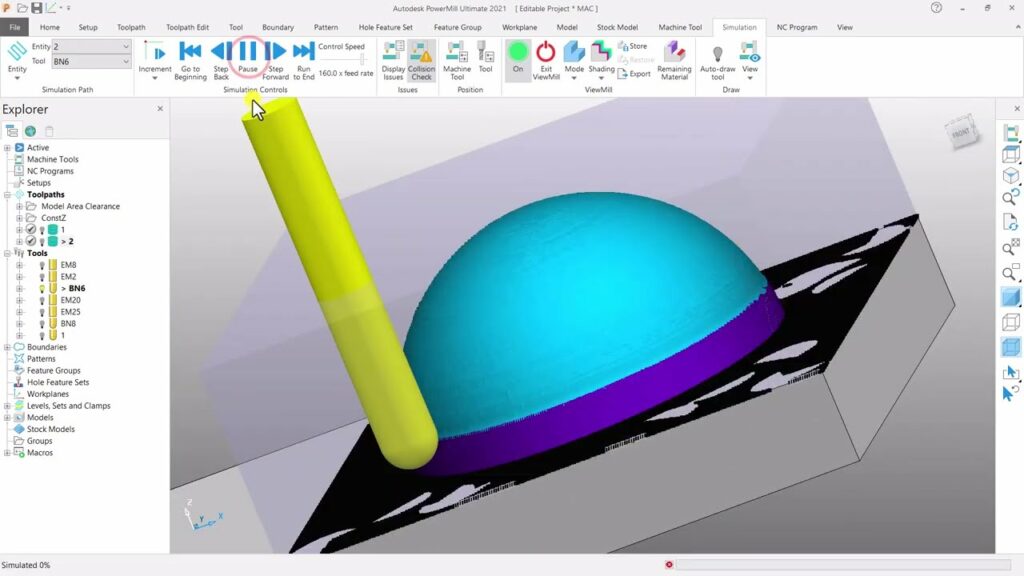PowerMill Ultimate: The Art of Chip Removal – A Comprehensive Guide to Optimizing Cutting Strategies

PowerMill Ultimate empowers you not only to generate toolpaths but to craft masterful cutting strategies. These strategies define how the cutting tool interacts with the workpiece, influencing factors like material removal rate, surface finish, machining time, and ultimately, the quality and cost-effectiveness of the finished part. This comprehensive guide delves into the world of cutting strategy optimization in PowerMill Ultimate, equipping you with the knowledge and techniques to transform your machining processes from good to great.
The Fundamental Principles: Understanding the Machining Trinity
Before optimizing cutting strategies, it’s crucial to grasp the fundamental principles that govern metal removal:
Tool Geometry: The shape, size, and material of the cutting tool significantly impact chip formation and cutting forces. Selecting the appropriate tool for the material being machined is paramount. Different tool geometries excel in different scenarios. For instance, ball nose end mills are ideal for creating smooth contours and radii, while flat end mills are workhorses for generating flat surfaces and pockets. Each tool geometry influences chip formation and requires tailored cutting strategies to achieve optimal results.
Workpiece Material: Different materials have varying properties that influence machinability. Understanding the material’s hardness, ductility, and chip formation characteristics is essential for crafting effective cutting strategies. Ductile materials, like aluminum, tend to generate long, stringy chips that can clog flutes and cause tool wear. Brittle materials, like cast iron, tend to generate small, discontinuous chips that might leave a rough surface finish if not cleared effectively. Selecting appropriate cutting speeds, feed rates, and chip loads based on the material properties ensures efficient chip removal and minimizes machining issues.
Machine Capabilities: The power and rigidity of your CNC machine tool limit the aggressiveness of your cutting strategy. High-powered machines can handle higher spindle speeds and feed rates, enabling faster material removal. Less rigid machines might require more conservative cutting parameters to avoid tool deflection and vibrations that can compromise surface finish and dimensional accuracy. PowerMill Ultimate allows you to factor in your machine’s specifications during toolpath generation, ensuring the chosen cutting strategies are achievable within the capabilities of your equipment.
By considering these fundamental principles, you establish a solid foundation for optimizing cutting strategies in PowerMill Ultimate.
Delving Deeper: Core Strategies for Mastering Chip Removal
Now that you understand the machining trinity, here are some core strategies to consider when optimizing cutting strategies in PowerMill Ultimate:
Balancing Cutting Speed and Feed Rate: There’s an inverse relationship between cutting speed (RPM) and feed rate (mm/min or in/min). Higher cutting speeds result in thinner chips but generate more heat. Conversely, lower cutting speeds produce thicker chips but generate less heat. Finding the optimal balance between these two parameters is crucial for efficient chip removal, tool life, and surface finish. PowerMill Ultimate provides recommendations based on the selected tool and material, but user experience and material testing can further refine these recommendations.
Chip Load: The Key to Efficiency: Chip load (mm/tooth or in/tooth) represents the thickness of the chip removed by the cutting tool with each revolution. Utilizing an appropriate chip load ensures efficient material removal and minimizes cutting forces. A chip load that’s too low can lead to rubbing and accelerated tool wear. Conversely, a chip load that’s too high can generate excessive cutting forces, causing tool deflection and potential machine overload. PowerMill Ultimate calculates chip load based on the chosen cutting speed and feed rate, but adjustments might be necessary to achieve optimal chip formation for the specific material being machined.
Roughing vs. Finishing Strategies: The strategies employed for roughing and finishing operations differ significantly. Roughing aims to remove the bulk of the material as quickly as possible. Here, higher feed rates and increased chip loads are often employed to expedite the process. Finishing strategies prioritize achieving a smooth surface finish and dimensional accuracy. Lower feed rates and smaller step-over values (the distance between adjacent tool passes) are typically used during finishing to minimize tool marks and ensure precise part geometry. PowerMill Ultimate allows you to define separate toolpath strategies for roughing and finishing operations, optimizing each stage of the machining process for its specific purpose.
Advanced Techniques for Specific Applications: PowerMill Ultimate offers a plethora of advanced techniques for optimizing cutting strategies in specific scenarios. These include:
- Trochoidal Milling: A high-efficiency milling technique that utilizes a circular toolpath with a programmed offset. This technique can achieve higher material removal rates and better chip evacuation compared to conventional raster milling.
- Adaptive Milling: An intelligent approach where PowerMill Ultimate adjusts cutting parameters (spindle speed, feed rate) based on real-time sensor data, such as cutting forces. This allows for dynamic optimization of the cutting strategy throughout the machining process.




